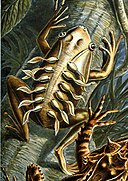קובץ:Haeckel Batrachia.jpg

גודל התצוגה המקדימה הזאת: 424 × 599 פיקסלים. רזולוציות אחרות: 170 × 240 פיקסלים | 339 × 480 פיקסלים | 543 × 768 פיקסלים | 724 × 1,024 פיקסלים | 2,323 × 3,284 פיקסלים.
לקובץ המקורי (2,323 × 3,284 פיקסלים, גודל הקובץ: 2.17 מ"ב, סוג MIME: image/jpeg)
היסטוריית הקובץ
ניתן ללחוץ על תאריך/שעה כדי לראות את הקובץ כפי שנראה באותו זמן.
| תאריך/שעה | תמונה ממוזערת | ממדים | משתמש | הערה | |
|---|---|---|---|---|---|
| נוכחית | 06:17, 24 בפברואר 2006 |  | 3,284 × 2,323 (2.17 מ"ב) | Ragesoss | improve version, based on same original scan |
| 03:22, 11 בפברואר 2006 |  | 3,280 × 2,318 (2.21 מ"ב) | Ragesoss | The 68th plate from Ernst Haeckel's 1899 ''Kunstformen der Natur'', depicting frogs classified as Batrachia. Category:Ernst Haeckel |
שימוש בקובץ
הדפים הבאים משתמשים בקובץ הזה:
שימוש גלובלי בקובץ
אתרי הוויקי השונים הבאים משתמשים בקובץ זה:
- שימוש באתר arz.wikipedia.org
- שימוש באתר ast.wikipedia.org
- שימוש באתר az.wikipedia.org
- שימוש באתר ban.wikipedia.org
- שימוש באתר be.wikipedia.org
- שימוש באתר bg.wikipedia.org
- שימוש באתר ca.wikipedia.org
- שימוש באתר ca.wikibooks.org
- שימוש באתר ceb.wikipedia.org
- שימוש באתר ckb.wikipedia.org
- שימוש באתר dag.wikipedia.org
- שימוש באתר de.wikipedia.org
- שימוש באתר din.wikipedia.org
- שימוש באתר el.wikipedia.org
- שימוש באתר en.wikipedia.org
- Wikipedia:Featured pictures thumbs/04
- Wikipedia:Picture of the day/June 2006
- User:Ragesoss/Haeckel
- Wikipedia:Featured picture candidates/Haeckel Batrachia.jpg
- Wikipedia:Wikipedia Signpost/2006-03-13/Features and admins
- Wikipedia:Featured picture candidates/March-2006
- Talk:Frog/Archive 3
- User talk:Ragesoss/Archive1
- Wikipedia:Picture of the day/June 12, 2006
- Wikipedia:POTD/June 12, 2006
- Wikipedia:POTD column/June 12, 2006
- Wikipedia:POTD row/June 12, 2006
- Kunstformen der Natur
- User:Samsara/Frog/Stable
- User:RichardF/POTD
- Wikipedia:WikiProject Germany/Gallery
- User:Froggyyes~enwiki
- Wikipedia:Featured pictures/Animals/Amphibians
- Unclean spirit
- User:Xophist/s5
- Wikipedia:Wikipedia Signpost/2006-03-13/SPV
- Talk:Alfred Russel Wallace/Archive 1
- Portal:Amphibians/Selected picture
- User:The Transhumanist/Sandbox144
- Template:POTD/2006-06-12







